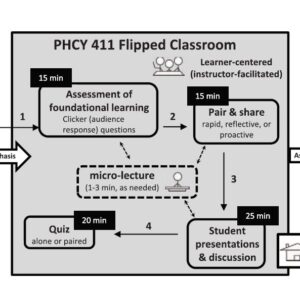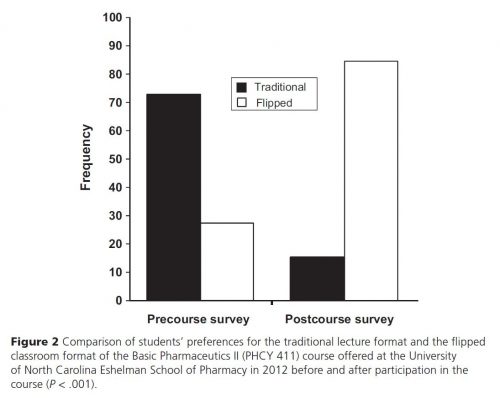The Flipped Classroom: A Course Redesign to Foster learning and Engagement in a Health Professions School (McLaughlin, et al., 2014)
summary
The authors flipped a first-year pharmacy course which resulted in an increase in students’ learning, class attendance, and perceived value of the flipped classroom model. The graph above describes how student preference for class style inverted: from favouring lecturing, to favouring flipping (even more strongly than the original preference), after they had experienced the flipped course. 91% agreed or strongly agreed that the flipped course format ‘greatly enhanced [their] learning’.
for meristem students and parents
The average grade of all students was increased (with statistical significance) after the very first semester they trialled flipping.
for meristem teachers
The paper provides one example of a flexible active lesson format and micro-assessment incentives for students to stay up-to-date with class content:

‘Students ‘ presentations (worth 1.6% of the final grade), eight graded quizzes (worth a total of 12.9%), three scheduled examinations (each worth 16.1%), and one comprehensive and cumulative final examination(worth 32.3%)… Finally students received bonus points for responding online to reflective pair & share questions (worth up to an additional 1.6%) or facilitating a proactive pair & share activity (worth up to an additional 3.2%).
For development of meristem
For this course the conveners also provided students with a syllabus that gave a thorough description of the course and format, as well as the motivation behind the shift in pedagogical strategy. Tips for success were provided and established the expectations on students. We are investigating how to provide this to meriSTEM teachers and students.
McLaughlin, J.E., Roth, M.T., Glatt, D.M., Gharkholonarehe, N., Davidson, C.A., Griffin, L.M., Esserman, D.A. and Mumper, R.J., 2014. The flipped classroom: a course redesign to foster learning and engagement in a health professions school. Academic Medicine, 89(2), pp.236-243.

